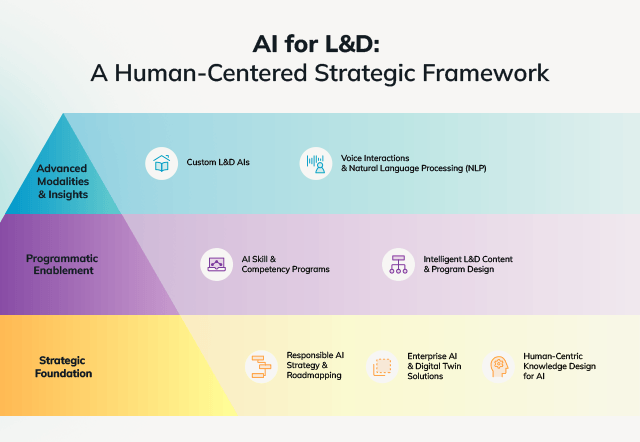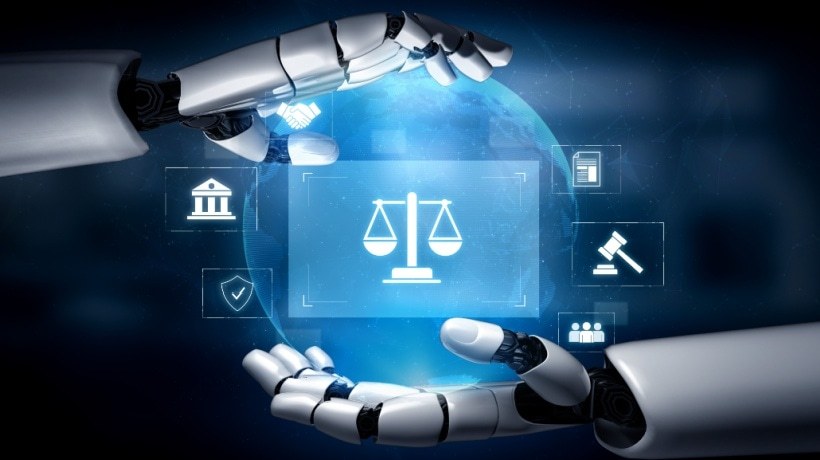AI In Our Organizations: The Current State
It's 2025, and AI is no longer knocking at our doors: It's already in the building.
Our people are using AI for a wide range of daily tasks, the demand for candidates with AI skills is growing, and AI is itself an important tool in the recruiting process.
Meanwhile, L&D and talent leaders have moved beyond outsourcing rote tasks to AI and are now engaging it as a strategic and creative partner. As we continue to dream bigger, our AI ambitions unfold within the larger context of our organization's AI strategy and policies.
Here's how a few different stages of adoption might look:
Scenario 1
The organizations that recognized AI's transformational power early in the game have built an AI ecosystem where AI and human knowledge live and thrive together—and are already seeing the ROI of their efforts.
These successful adopters, characterized as Frontier Firms by the latest Microsoft Work Trends Report, "blend machine intelligence with human judgment, building systems that are AI-operated but human-led."
Every employee embodies their organization's AI strategy, thanks to enterprise-wide training on AI guidelines, ethics, and role-based AI skills and tools. In-house AI tools for every business function draw upon a shared knowledge base of specialized terms, branding language, and institutional wisdom.
Finally, the organization has clear processes for human oversight and review to catch any "hallucinations," inaccuracies, and bias in AI outputs—before they have a chance to harm the organization's relationships or reputation.
These organizations aren't unicorns: This level of digital transformation is within reach for every organization. We'll share some steps for creating a solid foundation you can build upon for years to come.
eBook Release
The AI Blueprint: Actionable Strategies For L&D Leaders To Reduce Risk, Add Value, And Unlock The Benefits Of AI At Scale
Discover how to reduce risk, maximize value, and create AI-powered efficiencies that empower your teams (and business!) to thrive.
Scenario 2
Other organizations are leveraging AI on a more ad hoc basis: Certain teams leverage AI tools for specialized use cases, for example, to screen job applicants or field customer inquiries. Other teams might still be looking for a compelling use case.
It's on the individual level that AI is flourishing: Team members are tapping into a virtual smorgasbord of AI tools to help them take meeting notes, summarize lengthy reports, and generate code, images, text, and other content.
We applaud their initiative and curiosity!
Caveat: Without organization-wide AI usage guidelines, security standards, vetted tools, and procedures for human oversight and review, individual AI users are inadvertently opening the door to substantial risk.
These risks range from publishing inaccurate or biased AI-generated content to sharing sensitive information with an AI tool that "learns" from it…and later passes it on to other users.
If this scenario feels a little too close to home, read on to transform your ad hoc approach into a safe, productive AI strategy that empowers your people and extends your (already mighty) in-house wisdom.
Scenario 3
Still other organizations have banned AI outright. Their (understandable!) goal: Protect sensitive information, intellectual property, or even personal safety.
Financial or government institutions, as well as developers of leading-edge technology, might adopt this stance simply because they have so much to protect.
By keeping AI off-limits, these organizations are losing out on the potential benefits of AI—and keep their people behind the curve. There may be AI power users on staff but, because AI is treated as a liability, they're not allowed to share their superpower.
Does that mean everyone checks their AI tools at the door? Unlikely.
Whether their answer to AI adoption is "not yet" or a hard "never," these organizations face a hard truth: AI is already in the building.
Three out of four employees currently bring their own AI tools to work to meet the ever-mounting demands to do more, better, and faster—and over half are reluctant to admit that they use it. And by using unvetted AI tools, without consistent human oversight, they're risking their organizations' data security, trade secrets, and reputation.
If you're looking to replace resistance with realism, our guide to responsible AI strategy will help you embed security and responsibility from the ground up.
The Common Theme: AI
AI is in every organization described above, but only those in Scenario 1 have met it with a proactive governance, implementation, and usage strategy. Without this foundation, organizations face the following risks:
IP and Data Security: Without clear guidelines, the use of AI tools can inadvertently compromise sensitive organizational and client data.
"Without guidance or clearance from the top, employees are taking things into their own hands and keeping AI use under wraps…This approach means missing out on the benefits that come from strategic AI use at scale. It also puts company data at risk in an environment where leaders' #1 concern for the year ahead is cybersecurity and data privacy."—Microsoft Work Trend Index Annual Report, 2024
Quality Assurance (QA) and Inconsistency: When individuals with varying levels of AI expertise use different AI tools to complete job-related tasks, the outputs can be inconsistent, of varying quality, and based on incomplete knowledge and context.
Duplicated Efforts: Without centralized AI knowledge bases that start everyone on the same page, multiple teams or individuals tackle similar AI-driven tasks independently, leading to inefficient, duplicated efforts and outputs of varying quality (see QA above).
Ethics and Accuracy: Lacking a clear review process, teams and individuals are at risk of using, and even publishing, AI outputs that are inaccurate, biased, or otherwise misaligned with organizational values.
Reputational and Legal Harm: Inaccurate or biased AI outputs that are published or leaked to the public can jeopardize an organization's reputation and/or legal standing.
Missed Opportunities: Research by Randstad found that most workers view their companies as lagging in AI integration. Meanwhile, the World Economic Forum reports that a full 50% of global executives cite lack of skills as their biggest barrier to AI adoption. In short, the L&D opportunity is immense.
Addressing these risks and capturing the AI opportunity requires a proactive and strategic approach..and a timely one.
We've talked before about how, as L&D leaders, we're in the perfect position to host the conversation about AI, and that's still true! But now that the conversation is already underway—and many of us face ad hoc AI implementation efforts or outright bans—we need to approach it differently.
We're optimists, so we believe that AI can be a force for good that helps us connect, create widespread abundance, and generally do more good in the world.
We're on the cusp of an era of transformation on par with the invention of the printing press, the Industrial Revolution, and the dawn of the internet.
Imagine being able to look back at this extraordinary moment in human history and say not only, "I was there," but "I helped make it happen."
Let's do this.
"We are at this moment where we could actually play a difference in shifting the zeitgeist of this country, potentially the world. And it's not out of the question that people in 50, 100, 1,000 years from now, they're going to look back and say, "Ah, people in that period, they figured out AI. They finally got over to AI, and the AI that we're still using centuries in the future." —Peter Leyden, The Great Progression Explained
From Sepia To Technicolor: The Current State Of AI In L&D
For years, we've built highly effective L&D programs and offered our learners a rich blend of modalities.
In the age of AI, we're facing a major shift: Our role as L&D leaders now entails curating dynamic content that creates even deeper, more impactful learning.
With AI, we can amplify our impact by offering learners agency, active exploration, and truly personalized experiences.
The benefits are also business-facing: Integrating AI into the powerful work of learning and skilling helps us add even more value. Read on to discover the four key areas.
The AI Value-Add: Four Key Areas
Personalization at Scale: Adapting learning to individual needs while seamlessly connecting vast organizational knowledge, often through the power of custom knowledge bases—a topic we'll explore in a companion article.
Immersion and Agency: Engaging the entire learner in freeform exploration and engagement with AI-powered, 3D, immersive digital experiences in virtual reality (VR), augmented reality (AR), and mixed reality (MR).
Content Curation: Using AI-driven insights to curate relevant and impactful learning journeys.
Business Impact and ROI: Where the other three values lead: measuring learning effectiveness and aligning L&D with your strategic goals.
Beneath it all, AI enables Deeper Organizational Insights, uncovering patterns and knowledge gaps that inform crucial business decisions.
Discover how to unlock all of the above with our human-centered strategic framework for AI in L&D. It's designed to help you systematically map your AI ecosystem, amplify human potential, and cultivate ethical, nuanced AI engagement across your organization.
AI For L&D: SweetRush's Human-Centered Strategic Framework
We'll explore the strategic pyramid in detail in three accompanying articles, each focused on a different level. For now, here's a preview of what each stage holds for L&D leaders, our organizations, and our people.

Strategic Foundation
Your essential AI groundwork: Secure data strategy and AI principles, custom knowledge bases for your in-house knowledge and expertise, and AI-VR pairing across functions.
Programmatic Enablement
Your foundational AI strategy in action: AI skilling and training for your workforce and expedited learning design and development with AI.
Advanced Modalities and Insights
Tailored, individual AI learning experiences—from coaching to immersive simulations—that draw upon your foundational assets and offer learners impactful, personalized solutions.
AI Strategy: The L&D Leader's Blueprint
Ready to advance the AI conversation at your organization? We've created a practical guide to help you build an AI strategy from secure foundation to peak implementation. Download The AI Blueprint: Actionable Strategies For L&D Leaders To Reduce Risk, Add Value, And Unlock The Benefits Of AI At Scale and begin surveying your digital landscape with your stakeholders, leaders, and team.









